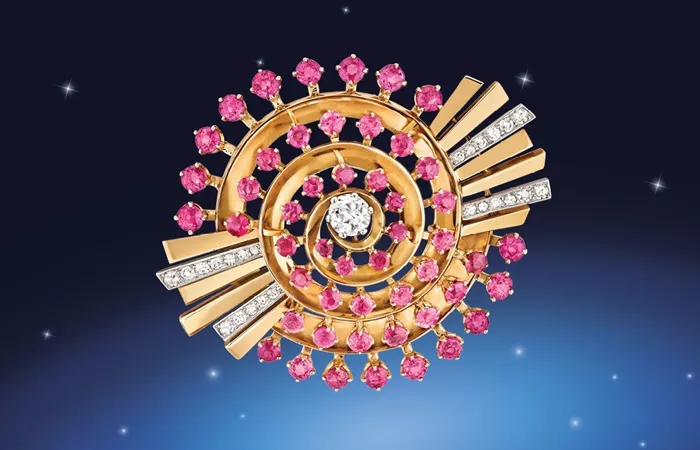The American Museum of Natural History’s newest exhibition, Cosmic Splendor: Jewelry from the Collections of Van Cleef & Arpels, opened on April 11, offering a mesmerizing journey through space and time.
This new exhibition showcases over 60 pieces of jewelry and timepieces from the renowned French jewelry house Van Cleef & Arpels. Celebrating nearly 100 years of design, the collection explores the mysteries of the universe, including the moon, stars, planets, and galaxies. It marks the second collaboration between the museum and the legendary jeweler.
Upon entering the Melissa and Keith Meister Gallery, visitors are immediately enveloped in an immersive atmosphere. The gallery, lit by thousands of tiny white lights reminiscent of the night sky, is further enhanced by a soundtrack featuring Audrey Hepburn’s “Moon River,” David Bowie’s “Space Oddity,” and Chet Baker’s “Star Eyes,” along with iconic NASA recordings, such as the Apollo 11 “We have liftoff” announcement.
The exhibition is organized into themed sections that reflect different celestial concepts, such as space, the universe, the moon, the sun, planets, stars, and the Zodiac. One of the earliest pieces on display is a 1930 Art Deco-style table clock made from yellow gold, silver, and enamel. Its sleek dial, featuring two gold beads for the hour and minute markers, suggests the movement of planets in the cosmos.
A standout piece in the Across the Universe display is the 1942 Spiral clip. Inspired by Kinetic Art, this creation combines platinum, yellow gold, rose gold, rubies, and diamonds to mimic the swirling effect of a star or galaxy. Other pieces celebrate the Zodiac, such as a collection of rings and pendants from the 1970s in the Lucky Stars display.
Van Cleef & Arpels is known for creating jewelry that often offers more than meets the eye. In the Beyond Earth display, visitors can see the Trappist transformable necklace, named after the TRAPPIST-1 star system. This 2021 piece can be worn in 11 different ways, including as nine necklaces, a clip, or a pair of earrings.
Another example of transformative design is the Explosion Stellaire transformable necklace from 2021. Made of white gold, rose gold, sapphires, and diamonds, this piece can be split into two necklaces, with the pendant detachable to be worn as a brooch.
Among the exhibition’s treasures is a gold medallion clip, etched with the autographs of the Apollo 11 astronauts, found in the Lunar Wonders display case. Nearby, the Autour de la Lune clip, from 2010, employs a watch mechanism to depict a rocket orbiting the moon, crafted from white gold, lapis lazuli, and diamonds.
Some pieces are inspired by specific astronomical events, while others draw more loosely from celestial wonders. The Tampa Necklace (2010), for example, pays homage to Jules Verne’s novel From the Earth to the Moon, featuring a gem-encrusted space capsule with diamond loops tracing its flight. Like several other pieces, the pendant can be detached and worn as a clip.
In a statement, Sean M. Decatur, president of the museum, expressed excitement about the collaboration: “We are thrilled to partner with Van Cleef & Arpels to celebrate the cosmos through this stunning display of creativity and craftsmanship.” Catherine Renier, CEO of Van Cleef & Arpels, added, “The Museum is the perfect place to share our fascination with the cosmos.”
Cosmic Splendor will be open to the public until January 4, 2026. Admission to the exhibit is included with general museum entry.
Related topics:
- Eliana Curated Jewelry Boutique Opens in Clarendon
- Gold Prices Hit Record High, Boosting Jewellery and Bullion Sales
- Suspect in Quezon Jewelry Shop Robbery Arrested in Rizal


